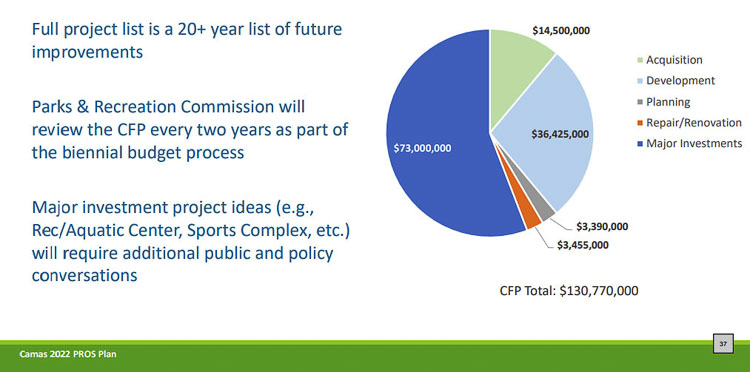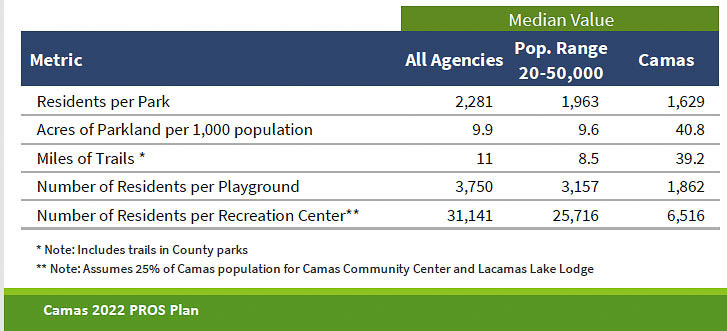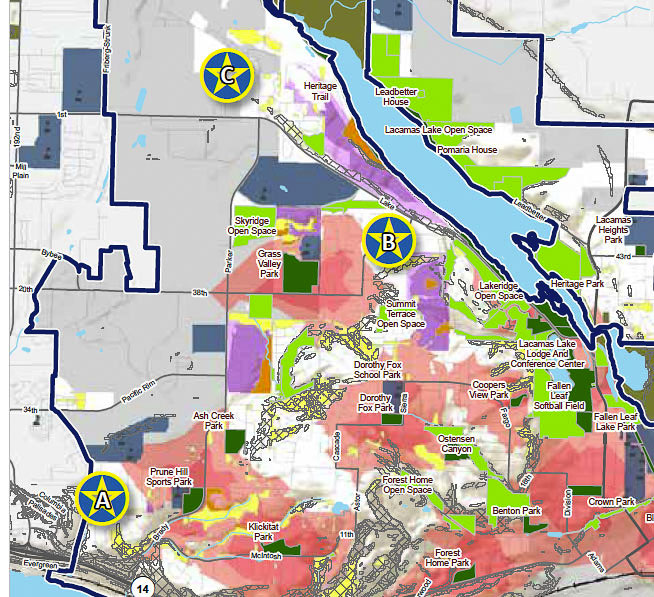City already has more parks and recreation facilities than most cities its size
Camas is the land of plenty. Since 2003, the city’s open space network has grown by over 50 percent in terms of city-owned acreage. It has over four times the number of acres of parks than similar sized cities. The number of parks exceeds what most cities have as well.
Camas has over four times the miles of trails – 39.2 miles per 1,000 people versus 8.5 miles for similar sized cities. The city has more playgrounds for its people and recreation centers as well.
In the past few years, the city has spent nearly $26 million to purchase hundreds of acres of land along the north shore of Lacamas Lake and 110 acres in Green Mountain. This has happened in the aftermath of citizens rejecting a $78 million bond for a pool and recreation center in 2019.
At last week’s Camas City Council workshop, Parks and Recreation Director Trang Lam said “it’s a scary number” regarding the $130 million total projected cost. She spoke about prioritizing and that it’s a 20-year plan. Contained within the proposed Parks, Recreation, and Open Space (PROS) plan is $73 million in major investments, $14.5 million in additional acquisitions, and the balance in planning, development, and maintenance.

The top four expenditures were $43 million for a Recreation/Aquatic Center, $20 million for a Sports Complex, $10 million for another Community Center, and $6.2 million for Crown Park development. Of note was $2 million for Leadbetter House redevelopment, which the city acquired as part of the $22 million legacy lands.
Steve Lorenz, commission chair, noted the plan and citizen input will serve as a guide directing actions and activities for the Parks and Recreation Commission for the next six years. The plan has 62 action items and a cost of $118 million.
Citizens can weigh in via an online survey or get more details here. Members of the City Council will vote on adopting the plan at their March 7 meeting.
The city of Camas owns and manages 1,068 acres of parks and open spaces, which supports a range of active and passive recreation experiences. The parks and recreation system provides developed parks with playgrounds, public waterfront access sites, active recreational facilities for team sports, a skate park and many miles of walking paths and trails.
The city has four times the acreage of parks per citizen than most other cities in the 20,000 to 50,000 population range. Camas is especially noteworthy for its 39 miles of hiking and walking trails. The city also has more playgrounds and recreation centers than others.
Clark County also has 891 acres of open space lands, and local homeowner associations own an additional 385 acres that people can enjoy, according to the report. The city has added 460 acres since 2010 according to Steve Duh, a consultant with Conservation Technix, Inc.
Underlying the discussion is an expected growth in population by 8,000 people to 34,000 residents in the year 2035.
Furthermore, in the past two years, the city has spent $22 million to acquire “legacy lands” along the north shore of Lacamas Lake, and another $3.8 million to acquire 110 acres of property on Green Mountain. These two land acquisition efforts removed hundreds of homesites, which would have handled much of the needed housing for the projected population growth.
The city currently relies on Park Impact Fees (PIF), Real Estate Excise Taxes (REET), and assorted other funds to finance individual projects or programs for their parks and recreation programs.
“The Camas community is reaching a size that will result in greater public demand for major facilities investments such as a recreation center with aquatics programs and a sports field complex,” the proposal states. Yet just two years ago, citizens rejected a planned $78 million recreation center, pool facilities, and a possible sports complex. What has changed?

To address the perceived “needs” of the community, the Parks and Recreation staff and commission are proposing $130 million in “improvements” over the next 20 years. The details remain largely non-specific. Yet they say the voters will need to approve new taxes via a bond or levy to pay.
“Bond or levy will be needed to augment existing revenue to support major investments such as parkland acquisitions and development, trail development, recreational facilities, waterfront opportunities and general park element upgrades,” the proposed plan says.
The plan has many photos of people recreating outdoors in the community, including boating on Lacamas Lake. Yet citizen Marie Tabata Callerame reminded members of the City Council on Tuesday that for decades, multiple promises have been made to clean up the poisoned lake water, yet all the talk has failed to produce positive results.
Lake water quality has become more of an issue as “caution” and “warning” signs have been posted at a record number of times in recent years, as levels of toxins have exceeded acceptable levels according to health officials.
The Parks and Rec plan takes input from statewide surveys, complemented with a survey that had 1,600 responses from Camas citizens, or about 6 percent of the population.
According to the report, more than three in four respondents are very or somewhat supportive of adding walking trails (88 percent), updated or renovated playgrounds at existing parks (82 percent), all-abilities accessible playground equipment (81 percent), and more picnic shelters (80 percent) to the city’s existing parks.
The city owns several properties that are intended to serve as neighborhood parks, but are as of yet undeveloped. The future planning and development of these sites will further improve the overall distribution of parks for the Camas community, and these sites have been accounted for in the gap analysis.
These future parks include:
- Ash Creek Park (future neighborhood park)
- Ostensen Canyon Park (future neighborhood park on approximately 8 acres of upper shelf)
- Lacamas Heights Park (future neighborhood park adjacent to Camas High School)
- Green Mountain property (pending community planning)
- North Shore Lacamas Lake (TBD, pending community planning)

One of the goals in the plan is to have a park within walking distance, a half mile of each neighborhood. Additionally, they show three areas on the west side of the city as “targets for acquisition” of new parks and recreation facilities.
Parking was mentioned as a concern, as more people use parks and outdoor space. Can the city’s transportation system handle the vehicle traffic and provide parking for citizens enjoying the recreation opportunities in the community?
Overall, the city does a good job maintaining it’s parks and recreation areas, according to Duh.
However, Callerame questioned the city’s efforts regarding cleaning up Lacamas Lake water quality. She laid out efforts over the past 30-40 years that have produced lots of studies and hired many consultants, but that have had minimal impact on cleaning lake water.
“A review of the program’s activities suggests there’s been no improvement in the lake’s water quality since the mid 1980s,” she said. Callerame emphasized that water quality is worse today than it was 10 years ago.
She noted the city has spent $100,000 on planning and PR. “We’ve not spent one penny on implementation,” she said. Callerame has been an advocate for Lacamas Lake water quality issues for the better part of a decade. She advocates for adding oxygen into lake water, and also wants the city to order the Lacamas Shores HOA to repair their broken biofilter.

One citizen has sued both the city and the Lacamas Shores HOA over the failed biofilter. According to Steve Bang, the city refuses to enforce water quality law and standards. They blocked efforts of the HOA several years ago to do repairs on their biofilter that handles stormwater.
At the council meeting, one citizen noted the city needs to take care of what they have before they spend millions to acquire additional lands and add new infrastructure.
The plan would, on average, seek $6.5 million per year to execute the plan. However they suggest using city bonding capacity to acquire needed funds.
According to the city budget, Camas maintains reserve debt capacity for local bonds and voter approved debt. The city’s non-voted general obligation debt is under its debt capacity limit of $41 million for non-voted debt. Community conversations regarding the potential to develop a recreation center with aquatics and/or bundle several projects from the Capital Improvements Plan warrant a review of debt implications and operating costs for the City, along with the need to conduct polling of voter support for such projects.
Members of the City Council will vote on the PROS plan at their March 7 meeting.





It would be nice if they would put in a REAL bathroom at Crown Park instead of the gross porta potty that’s been there for 10+ years, and put the basketball hoops back that they took out. Instead, they will put in a concrete splash pad. Not a fan.
More waste and excess spending. It’s like building a garden in your back yard. Right next to the garden you already have. In between that Koi Pond that’s all algae, but hey it’s fun to build. Fixing is for losers am I right?
Good work John Ley reporting on the continual problem with Camas economics. If the citizens would take a few minutes to look at and review the proposed spending they should be able to see that the real winners always have been the Developers, Contractors, Consultants, Lawyers and Landowners. Not the CITIZENS.
Wake up and pay attention to where the City’s money goes. 🤑🤑
We must fix Lacamas Lake. Without it all the rest of this is moot. We don’t want $43 million for a pool. Fix our lake.
Well, well, well. The editorial in the Post-Record yesterday exposed the lies and distortions in this fear mongering article. Maybe you could spend a little time trying to understand the subject matter before you spout off next time, John. Unless you don’t really care about being accurate, and just want to gin up fear and resentment. This paper could use a good deal more fact-checking and professionalism.